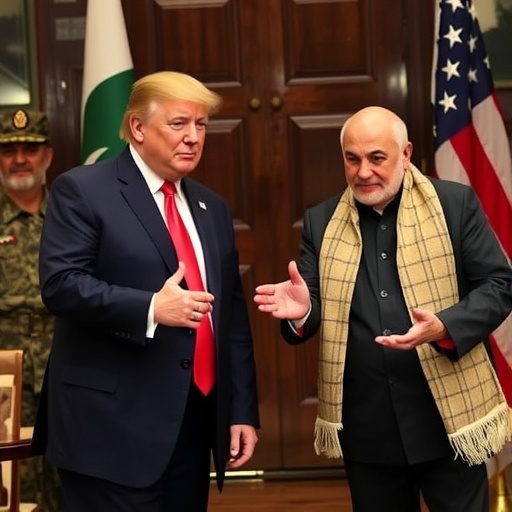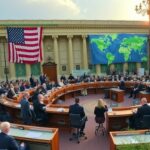Trump Vows Swift Fix for Afghanistan-Pakistan Crisis as Peace Talks Resume, Reviving U.S. Foreign Policy Debate
In a bold statement that has reignited discussions on America’s role in South Asia, former President Donald Trump declared on Wednesday that he could resolve the simmering Afghanistan-Pakistan crisis “very quickly” if given the chance, coinciding with the resumption of high-stakes peace talks between the two nations. The announcement, made during a rally in Florida, comes as diplomats from Kabul and Islamabad enter day two of negotiations in Doha, Qatar, aiming to ease border tensions and curb cross-border militancy that has plagued the region for decades.
- Trump’s Rally Declaration Ignites Speculation on Quick Resolution Tactics
- Day Two of Doha Peace Talks: Border Security Takes Center Stage
- Roots of the Afghanistan-Pakistan Tensions: A Legacy of Conflict and Mistrust
- U.S. Foreign Policy Crossroads: Trump’s Vision Versus Current Realities
- Prospects for Regional Stability: Challenges and Potential Breakthroughs Ahead
Trump‘s intervention underscores his signature style of injecting himself into global hotspots, even as he campaigns for a potential 2024 return to the White House. His words have drawn sharp reactions from policymakers, veterans of past U.S. engagements in the area, and regional experts, highlighting the enduring complexities of U.S. foreign policy in Afghanistan and Pakistan. With the Taliban in control of Afghanistan since the 2021 U.S. withdrawal, and Pakistan grappling with its own internal security challenges, the crisis remains a powder keg that could destabilize the broader Middle East and South Asia.
The peace talks, mediated by the United Nations and supported by international observers, focus on issues like the Durand Line border disputes, refugee flows, and the activities of groups like the Tehrik-i-Taliban Pakistan (TTP). Trump’s pledge adds a layer of intrigue, as it evokes memories of his administration’s 2020 Doha Agreement with the Taliban, which paved the way for the U.S. exit but left unresolved many bilateral frictions between Afghanistan and Pakistan.
Trump’s Rally Declaration Ignites Speculation on Quick Resolution Tactics
Standing before a cheering crowd in Miami, Trump didn’t mince words. “The mess in Afghanistan and Pakistan? I fixed it once before, and I can do it again—very quickly,” he proclaimed, gesturing emphatically. He referenced his brokering of the Abraham Accords in the Middle East as proof of his deal-making prowess, suggesting a similar “art of the deal” approach could pressure both nations into compliance. This isn’t Trump’s first foray into the topic; during his presidency, he authorized drone strikes against militants in both countries and hosted Pakistani Prime Minister Imran Khan in 2019 to discuss counterterrorism cooperation.
But what does a “very quick” solution look like in Trump’s vision? Sources close to his campaign indicate he favors leveraging economic incentives and military aid cuts—tactics he employed before. For instance, under Trump, U.S. aid to Pakistan totaled over $1 billion annually but was suspended in 2018 over allegations of harboring Taliban fighters. Reviving such conditional support could be key, experts say. “Trump’s style is high-pressure diplomacy,” noted Michael Kugelman, a South Asia analyst at the Wilson Center. “He might threaten to withhold IMF loans to Pakistan or impose sanctions on Afghan mineral exports to force concessions.”
The former president’s comments have already influenced market sentiments. Shares in U.S. defense contractors like Lockheed Martin rose 2% in after-hours trading, anticipating potential renewed engagements. Meanwhile, Afghan and Pakistani officials have remained tight-lipped, with a spokesperson for the Taliban government in Kabul stating only that “external interference must respect sovereignty.” This wariness stems from Trump’s past criticisms of Pakistan as a “highway for terrorists” and his abrupt 2019 tweet canceling aid, which strained bilateral ties.
Statistically, the crisis’s toll is staggering: Over 10,000 border clashes have been reported since 2021, according to the UN, displacing 500,000 people and exacerbating a humanitarian crisis where 24 million Afghans face acute food insecurity. Pakistan, hosting 1.4 million Afghan refugees, has conducted mass deportations, heightening tensions. Trump’s vow taps into American fatigue with endless wars—polls from Pew Research show 58% of U.S. voters oppose re-engagement in Afghanistan—yet promises a swift end that resonates with his base.
Day Two of Doha Peace Talks: Border Security Takes Center Stage
As Trump’s rhetoric echoed across the Atlantic, the peace talks in Doha pressed on, entering their second day with renewed vigor. Delegations from Afghanistan’s Taliban administration and Pakistan’s military-backed government convened under the auspices of UN Special Representative for Afghanistan, Roza Otunbayeva. The agenda, leaked to Reuters, prioritizes de-escalation along the 2,640-kilometer Durand Line, the colonial-era border that neither side fully recognizes.
Key demands from Pakistan include Afghanistan’s commitment to dismantle TTP safe havens, which Islamabad blames for a 50% surge in attacks on its soil last year—over 800 incidents, per the South Asia Terrorism Portal. In response, Afghan negotiators, led by Foreign Minister Amir Khan Muttaqi, insist Pakistan cease airstrikes into Afghan territory, which have killed dozens of civilians since 2022. “Peace requires mutual respect, not aggression,” Muttaqi told reporters outside the talks.
The sessions have seen incremental progress: Sources indicate an agreement in principle on joint border patrols, potentially involving 5,000 personnel from each side, monitored by neutral observers from China and Turkey. China, with $62 billion invested in Pakistan via the Belt and Road Initiative, has a vested interest; its ambassador to Pakistan urged “pragmatic dialogue” in a statement Tuesday. Turkey, meanwhile, offers mediation drawing from its own experience with Kurdish border issues.
Yet challenges abound. Internal divisions within the Taliban—between hardliners and pragmatists—could derail commitments, while Pakistan’s upcoming elections in 2024 add political volatility. One diplomat involved, speaking anonymously, described the atmosphere as “cautiously optimistic but fragile.” If successful, these talks could reduce cross-border incursions by 30%, per UN estimates, easing the strain on both economies battered by sanctions and inflation.
International involvement extends beyond the UN. The U.S., under President Biden, has sent a low-level observer team, signaling continued interest in stability to prevent ISIS-Khorasan resurgence. This contrasts with Trump’s more hands-on approach, fueling speculation about how a second Trump term might pivot U.S. foreign policy toward unilateral deals over multilateral efforts.
Roots of the Afghanistan-Pakistan Tensions: A Legacy of Conflict and Mistrust
To understand the crisis Trump aims to tackle, one must delve into its deep historical roots. The Durand Line, drawn in 1893 by British colonialists, has been a flashpoint since Pakistan’s 1947 independence. Afghanistan, viewing it as an arbitrary division of Pashtun lands, has never ratified it, leading to irredentist claims and proxy wars. The Soviet invasion of 1979 amplified divisions, with Pakistan serving as a conduit for U.S.-backed mujahideen fighters, fostering ties with what became the Taliban.
Post-9/11, the U.S. invasion of Afghanistan turned Pakistan into a reluctant ally, receiving $33 billion in aid from 2002-2021 but facing accusations of double-dealing. The 2021 U.S. withdrawal, negotiated under Trump, left a power vacuum that empowered the Taliban and emboldened the TTP, which now controls swaths of Pakistan’s tribal areas. Recent data from the Costs of War Project at Brown University estimates 176,000 direct deaths from the Afghan conflict, with spillover effects claiming 60,000 Pakistani lives.
Mistrust persists: Pakistan alleges Afghanistan shelters anti-Pakistani militants, while Kabul accuses Islamabad of supporting the Taliban’s 2021 offensive. Economic interdependence offers a counterbalance—bilateral trade hit $2.5 billion in 2023—but sanctions on Afghanistan have crippled cross-border commerce. Refugees add another layer; Pakistan’s 2023 deportation drive, affecting 800,000 Afghans, sparked riots and diplomatic protests.
Trump’s familiarity with these dynamics dates to his 2017 South Asia strategy, which increased U.S. troops in Afghanistan to 14,000 and pressured Pakistan. Critics, like former U.S. Ambassador Ryan Crocker, argue in a recent Foreign Affairs op-ed that quick fixes ignore structural issues: “The border isn’t just a line; it’s a cultural faultline.” Nonetheless, Trump’s vow has spotlighted these tensions, prompting calls for renewed U.S. mediation.
U.S. Foreign Policy Crossroads: Trump’s Vision Versus Current Realities
Trump’s pledge arrives at a pivotal moment for U.S. foreign policy in the region. The Biden administration has adopted a hands-off stance post-withdrawal, focusing on counterterrorism over nation-building, with drone operations continuing from bases in the Gulf. Annual U.S. aid to Pakistan has dwindled to $300 million, mostly military, while Afghanistan receives humanitarian support via third parties to bypass Taliban control.
A Trump return could upend this. Campaign advisors have floated ideas like recognizing the Taliban in exchange for anti-ISIS cooperation and tying Pakistan aid to border security pacts. “America First means smart power, not endless commitments,” Trump reiterated in his rally, echoing his 2017 address that tripled Afghan troop levels before negotiating the exit.
Experts are divided. Vali Nasr, author of “The Dispensable Nation,” warns that unilateral moves could alienate allies like India, which views Pakistan warily and has deepened ties with the U.S. via the Quad. Conversely, Bruce Riedel of the Brookings Institution praises Trump’s deal-making: “He ended the war on paper; now he could broker real peace.” Polling from the Chicago Council on Global Affairs shows 62% of Americans want reduced involvement, but 45% support targeted diplomacy if it prevents terrorism export.
Broader implications include energy security—Afghanistan’s untapped $1 trillion in minerals could attract U.S. investment—and countering China’s influence. Pakistan’s alignment with Beijing via CPEC (China-Pakistan Economic Corridor) has irked Washington, with Trump once calling it a “strategic threat.” His quick-fix promise might involve trade deals to peel Pakistan away, though feasibility remains questionable amid domestic U.S. priorities like Ukraine and Gaza.
Prospects for Regional Stability: Challenges and Potential Breakthroughs Ahead
Looking forward, the Afghanistan-Pakistan peace talks could mark a turning point, but Trump’s shadow looms large. If negotiations yield a border management framework by week’s end—as optimists hope—it might stabilize the region, reducing militant safe havens and enabling $500 million in annual trade revival, per World Bank projections. Yet, failure risks escalation: Pakistan’s military has warned of preemptive strikes, while Taliban rhetoric hardens.
For U.S. foreign policy, the crisis tests post-Afghanistan strategies. A Trump-led intervention might accelerate deals but at the risk of alienating partners; Biden’s team, meanwhile, emphasizes multilateralism through the UN. International actors like Saudi Arabia, which hosted secret Taliban-Pakistan meetings in 2023, could bridge gaps. “Sustainable peace requires inclusive talks, not solo heroics,” urges UN Secretary-General Antonio Guterres.
Ultimately, resolution hinges on mutual concessions: Afghanistan curbing TTP, Pakistan easing deportations, and external powers like the U.S. providing incentives without domination. As talks continue, Trump’s vow keeps the spotlight on Washington, reminding the world that American influence in South Asia endures. Whether it leads to swift success or prolonged deadlock will shape global security for years to come.








